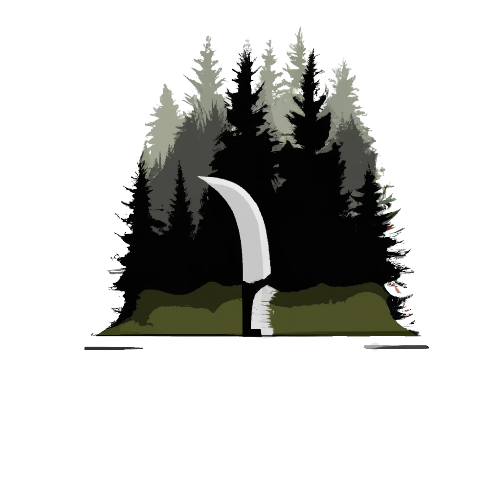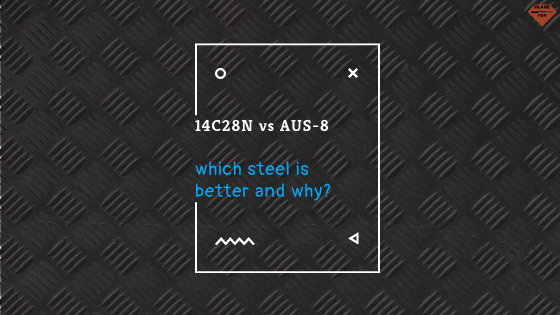AUS-8 and 14C28N are two of the more popular steels for upper mid-tier knives. Both steels are used by many big companies like SOG, Kershaw, and Ontario Knife Company. Since they’re two steels that are often to come into competition with each other, let’s compare the two to see which one you should get and when.
Here is the short answer:
14C28N will have better edge retention and slightly better corrosion resistance when compared to AUS-8. However, AUS-8 will be easier to sharpen and has slightly better toughness. 14C28N is generally considered the better steel and is used for tools that need a really sharp blade (like scalpels).
Now we can take a deeper dive into this article and see why one is better than the other.
14C28N
14C28N is a steel that has pretty good corrosion resistance and pretty good edge retention. It is a good steel for almost all EDC knife tasks. It’s generally used for things like kitchen knives and scalpels–things that need to be really sharp. So, for activities where you need a sharp knife, 14C28N is likely to be a good choice.
The biggest downside to 14C28N is its toughness. 14C28N is not a very tough steel, meaning that if you are going to be hard on your knife, you may want to look elsewhere.
Here is what 14C28N is made of:
- 0.62% Carbon
- 14% Chromium
- 0.6% Magnesium
- 0.2% Silicon
- 0.02% Phosphorus
- 0.01% Sulfur
- 0.11% Nitrogen
Carbon increases edge retention and steel strength. Chromium helps with a steel’s corrosion resistance (any steel with a chromium level above 11% is considered stainless). Vanadium increases wear resistance. Molybdenum will increase the chances of getting a better heat treat. Magnesium, silicon, and sulfur increase steel strength–much like carbon. Nitrogen in steels increases the strength and edge retention.
AUS-8
AUS-8 is a pretty general-purpose steel: It’s not bad in any area, and not the best in any area. If you were looking for a steel that is just all around decent, this would be the one to look at.
The biggest problem with AUS-8 is its edge retention. Depending on its heat treat AUS-8 will either have great edge retention, or it will have pretty bad edge retention. Generally speaking, AUS-8 has below-average edge retention.
Here is what AUS-8 is made of:
- Carbon: 0.75%
- Chromium: 14.5%
- Manganese: 0.5%
- Molybdenum: 0.3%
- Nickel: 0.49%
- Silicon: 1%
- Vanadium: 0.26%
Which one is better?
Now that we have taken a closer look at each steel, we can take a deeper dive into which one is better.
When it comes to edge retention, 14C28N is better. If you need a knife steel that requires a blade that stays sharp for a fairly long time, you’ll want 14C28N. While AUS-8 can have similar edge retention, generally 14C28N will be better.
Both steels will have very similar corrosion resistance. Both steels have almost the same level of chromium so they will have very similar corrosion resistance.
When it comes to toughness AUS-8 is a better steel. It’s tougher because it has a higher carbon content than 14C28N. So if you need a tough steel for batoning or other heavy tasks, then you will want AUS-8.
Our favorite knives in each steel
Since we have taken a closer look at each steel and which one is better we can see what the best knives are in each steel.
Kershaw Leek (14C28N)
The Kershaw Leek is a knife that is an ideal EDC knife. It has a 3.5-inch blade, a stainless steel handle, a blade lock, and has assisted opening. If you want a good all-around EDC knife, the Kershaw Leek is for you.
Check out this knife here (link to Amazon)
Ontario Knife Company RAT (AUS-8)
The RAT is one of OKC’s (Ontario Knife Company) most popular folding knives. It has a nylon handle, AUS-8 blade, a thumb stud, and a standard inner lock. It’s a reliable, standard knife that works well for all EDC uses.
Check out this knife here (link to Amazon)
Conclusion
If you need a steel you can beat up, you’ll want to go with AUS-8. If you want a steel that can get and stay super sharp, go for 14C28N. Generally 14C28N is considered better, but either of the steels will work for EDC knife uses.
Check out more articles here.

